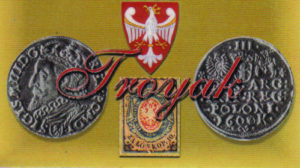
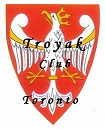
TROYAK EXECUTIVE TEAM is informing all members, colleagues, collectors, and Polonia at large, that Club meetings taking place at John Paul II Polish Cultural Centre, 4300 Cawthra Rd. (just south of Hwy. 403), Mississauga, Ontario. The new members are always welcome. www.polishculturalcentre.ca
ADRES SPOTKAÑ KLUBOWYCH ! Zarząd Główny Klubu “Troyak” informuje wszystkich członków kolekcjonerów, sympatyków oraz całą Polonię, że spotkania klubowe odbywają się w Polskim Centrum Kultury im. Jana Pawła II, przy 4300 Cawthra Rd. (na południe od autostrady 403), Mississauga, Ontario. Zapraszamy nowych członków do prężnego. Klubu “Troyak”. www.polishculturalcentre.ca

“TROYAK” CLUB NEXT MEETINGS …
NASTĘPNE SPOTKANIA KLUBU “TROYAK” …
Sunday – 26th June 2022 @ 4:30 p.m.
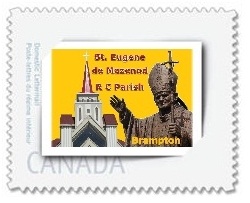
July & August 2022 – Summer break … Letnie wakacje …

25th September 2022

Sunday – 2nd October 2022 @ 9:00 a.m. to 4:00 p.m.
Mississauga Coin & Stamp Show
30th October 2022
27th November 2022
December 2022 … Happy Holidays!


Józef Mackiewicz
www.poczta-polska.pl
W dniu 1 kwietnia 2022 r. Poczta Polska upamiętniła emisją filatelistyczną wybitnego polskiego pisarza oraz publicystę – Józefa Mackiewicza. Walor wprowadzony został do obiegu w 120. rocznicę urodzin autora znanej maksymy „tylko prawda jest ciekawa”. Znaczek wpisuje się także w ustanowione przez Sejm RP obchody Roku Józefa Mackiewicza i to właśnie w gmachu polskiego parlamentu nastąpiła uroczysta prezentacja wydawnictwa filatelistycznego. Prezentacja znaczka miała miejsce 31 marca w Sejmie RP, podczas konferencji poświęconej twórczości i dorobkowi Józefa Mackiewicza, zorganizowanej przez Instytut Pamięci Narodowej. Walor uroczyście odsłonił Wiesław Włodek, wiceprezes Poczty Polskiej.
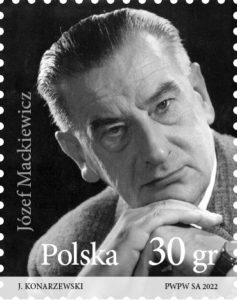
Został wprowadzony do obiegu znaczek pocztowy o wartości 0,30 zł emisji “Józef Mackiewicz”. Na znaczku zaprezentowano zdjęcie pisarza i publicysty Józefa Mackiewicza z 1966 roku. Wzdłuż dolnej krawędzi umieszczono napis: Polska oraz nominał wartości 30 gr. Znaczek wydrukowano techniką rotograwiurową, na papierze fluorescencyjnym, format znaczka: 25,5 x 31,25 mm, w nakładzie 5 000.000 szt, powtarzalnym. Arkusz sprzedażny zawiera 100 znaczków. Z tej okazji została wydana również koperta FDC. Autor projektu: Jacek Konarzewski. Na kopercie zdjęcie Józefa Mackiewicza z córką Haliną, Ostra Brama, Wilno 1938 r, fotografia ze zbiorów rodzinnych oraz cytat:” ….tylko prawda jest ciekawa”.Datownik: podpis JM. Sejm ustanowił rok 2022 rokiem Józefa Mackiewicza! … ,,zawód: pisarz, narodowość: antykomunista, przekonania: kontrrewolucjonista, kraj pochodzenia: Europa Wschodnia” – w taki sposób przedstawiał samego siebie Józef Mackiewicz.
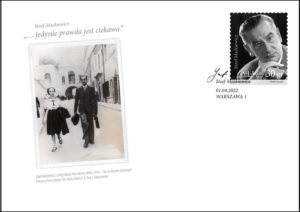
Józef Mackiewicz … denomination: 0,30 PLN;
number of stamps in set: 1 (100 pcs in sheet);
print run: 5 000 000 pcs.; paper: fluorescent;
printing techniques: photogravure; number of FDC: 1;
stamp size: 25,5 x 31,25 mm; author: Jacek Konarzewski;
circulation date: 1st April 2022.
Urodził się w Petersburgu, ,,jako syn Antoniego i Marii z Pietraszkiewiczów Mackiewiczów, 19 marca, starego stylu, (1 kwietnia) 1902 roku” – pisze Mackiewicz w życiorysie. To podkreślenie ,,starego stylu”, w symboliczny sposób charakteryzuje pisarza. Tak, Mackiewicz był człowiekiem starego stylu, tęskniącym do idei Wielkiego Księstwa Litewskiego, do Polski jako ,,kraju” wielonarodowego i wielokulturowego. Kawalerzysta – ochotnik w wojnie polsko-bolszewickiej 1920 r. Potem, do 1939 r., publicysta wileńskiego dziennika ,,Słowo”. W 1943 r. był świadkiem odkrycia grobów polskich oficerów, zamordowanych przez bolszewików, w Katyniu. Ujawnianiu prawdy o Katyniu poświecił całe życie. Po II wś, do śmieci w 1985 r., przebywał na emigracji w Londynie i Monachium. Autor powieści: Droga donikąd, Nie trzeba głośno mówić, Kontra oraz publicystyki: Zbrodnia katyńska w świetle dokumentów, Zwycięstwo prowokacji, W cieniu krzyża. Od 2002 r. jest przyznawana Nagroda Literacka im. Józefa Mackiewicza.

Sztuka sakralna
Sacred art
www.poczta-polska.pl
W dniu 12 kwietnia 2022 r. została wprowadzona do obiegu kartka pocztowa z nadrukowanym znakiem opłaty pocztowej, emisji: Sztuka sakralna. Wartość nominalna znaku opłaty pocztowej z oznaczeniem literowym A odpowiada wartości nominalnej znaczka pocztowego używanego do uiszczenia opłaty za ekonomiczną przesyłkę listową nierejestrowaną, w tym kartkę pocztową, w obrocie krajowym, w formacie S. W projekcie został zaprezentowany Kościół Świętej Trójcy i Najświętszej Marii Panny w Strzelnie, w części ilustracyjnej kartki budynek z zewnątrz, a na znaczku wnętrze Kościoła. Projekty powstały we współpracy z proboszczem Kościoła Świętej Trójcy i Najświętszej Marii Panny w Strzelnie, a wnioskodawcą emisji była Pani Poseł Ewa Kozanecka z Bydgoszczy. Bazylika pw. Św. Trójcy w Strzelnie jest jednym z cenniejszych, średniowiecznych obiektów architektonicznych w kraju. Kartkę o wymiarach 148 x 105 mm wydrukowano jednostronnie, techniką offsetową, na kartonie białym, w nakładzie 5000 sztuk. Autor projektu kartki: Jacek Konarzewski.
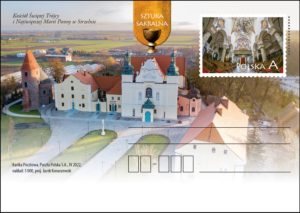
Sacred art … denomination: 3,60 PLN;
number of stationeries in set: 1; print run: 5.000 pcs;
printing technique: offset; card size: 148 x 105 mm;
author: Jacek Konarzewski; release date: 12th April 2022.

„EUROPA” Legendy i baśnie polskie.
Legenda o Kraku i smoku wawelskim
Europe
www.poczta-polska.pl
Poczta Polska będąca już dwukrotnie laureatem I. miejsca w konkursie na najpiękniejszy znaczek w Europie właśnie wystartowała w kolejnej jego edycji. Wszystkie poczty uczestniczące w rywalizacji mają za zadanie zaprojektować znaczek w ramach określonego odgórnie tematu. W tym roku emisja EUROPA dotyczy „Baśni i legend” (Stories and Myths”). EUROPA to seria znaczków wydawanych przez europejskie administracje pocztowe od 1956 r. Poczta Polska zdecydowała się przedstawić na znaczku legendę o Królu Kraku i smoku wawelskim.
W dniu 21 kwietnia 2022 r. został wprowadzony do obiegu znaczek pocztowy o wartości 4,50 zł emisji “Europa”. Znaczek wydrukowano techniką offsetową , na papierze fluorescencyjnym, w formacie znaczka 40,5 x 40,5 mm, w nakładzie 171.000 sztuk. Arkusz zawiera 9 znaczków. Format arkusza: 150 x 158 mm (3×3). Na znaczku przedstawiono smoka wawelskiego i szewczyka Skubę niosącego wypchanego siarką barana. W tle widnieje wzgórze z umownymi średniowiecznymi zabudowaniami zamku na Wawelu i smoczą jamą poniżej. Na kopercie FDC znajdują się wizerunki Skuby z owieczką na tle pokonanego smoka, zaś powyżej książę Krak z postacią niewiasty. Na datowniku okolicznościowym znajduje się nazwa: Legenda o Kraku i Smoku Wawelskim. Autor projektu znaczka: Maciej Jędrysik.
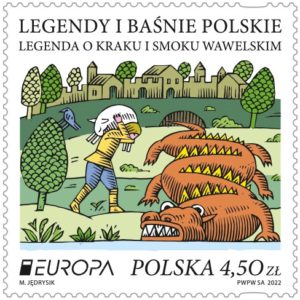
Europe … denomination: 4,50 PLN;
number of stamps in set: 1; print run: 171.000 pcs.;
printing techniques: offset; paper: fluorescent;
stamp size: 40,5 x 40,5 mm; sheet size: 150 x 158 mm;
9 stamps in sheet; author: Maciej Jędrysik;
number of FDC: 1; circulation date: 21st April 2022.
Poczta Polska jest zeszłorocznym laureatem konkursu EUROPA 2021 na najpiękniejszy znaczek pocztowy. W 2021 roku zdobyła to trofeum wydając walor filatelistyczny przedstawiający rysia euroazjatyckiego w emisji o temacie „Zwierzęta zagrożone wyginięciem” autorstwa Bożydara Grozdewa.
To niejedyny sukces Poczty Polskiej w konkursie filatelistycznym EUROPA. W 2020 roku polski operator narodowy wygrał w kategorii jury, proponując znaczek o tematyce „Dawne szlaki pocztowe”. W 2018 roku wydawnictwo Poczty przedstawiające most w Tczewie zajęło z kolei II. miejsce w głosowaniu internautów.
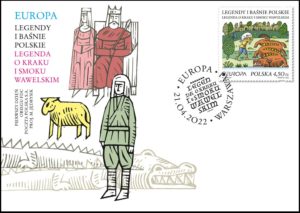
Emisja EUROPA stanowi serię wydawniczą rozpoczętą w 1991 r. w ramach współpracy z PostEurop. Wszystkie kraje członkowskie PostEurop wydają cyklicznie znaczki pocztowe o wspólnym temacie emisji. Zazwyczaj pokazują wspólne korzenie, kulturę, historię i cele narodów Europy. Znaczki te zawsze zawierają oficjalne logo EUROPA – znak towarowy stowarzyszenia publicznych administracji pocztowych PostEurop.
– Głównym celem corocznych emisji znaczków „Europa” od 66 lat jest próba pokazania wspólnych korzeni, kultury, historii i celów narodów Europy. Każdorazowo walory te, wydawane przez operatorów pocztowych skupionych w stowarzyszeniu PostEurop, promują przede wszystkim filatelistykę i pokazują, że współpraca pomiędzy europejskimi pocztami jest rzeczą naturalną. To zawsze jest bardzo ciekawa podróż przez historię i tradycje naszego kontynentu. To także od lat jedne z najbardziej pożądanych znaczków wśród filatelistów. Tematyka poruszana przy okazji emisji serii zawsze ma charakter edukacyjny – widzimy ile nas łączy i gdzie leżą nasze korzenie. Tym razem operatorzy europejscy pokazują najbardziej popularne dla swojego kraju baśnie i legendy. Wierzę, że nasz Smok Wawelski podbije serca nie tylko polskich klientów i filatelistów – powiedział wiceprezes Poczty Polskiej Wiesław Włodek.

30-lecie wznowienia polsko-gruzińskich
stosunków dyplomatycznych
30th Anniversary of the Reopening of
Polish-Georgian Diplomatic Relations
www.poczta-polska.pl
W dniu 28 kwietnia 2022 r. została wprowadzona do obiegu kartka pocztowa z nadrukowanym znakiem opłaty pocztowej, emisji: 30-lecie wznowienia polsko-gruzińskich stosunków dyplomatycznych. Wartość nominalna znaku opłaty pocztowej z oznaczeniem literowym A odpowiada wartości nominalnej znaczka pocztowego używanego do uiszczenia opłaty za ekonomiczną przesyłkę listową nierejestrowaną, w tym kartkę pocztową, w obrocie krajowym, w formacie S.
W projekcie zaprezentowane zostały barwy narodowe Polski i Gruzji, w części ilustracyjnej kartki znajdują się barwy narodowe w formie puzzli. Projekt jest kontynuacją serii kartek dedykowanych relacjom dyplomatycznym Polski z innymi krajami. Wnioskodawcą emisji była Ambasada Gruzji w Polsce. Planowana data wprowadzenia emisji 28.04.2022 r. WARSZAWA 1. Kartkę o wymiarach 148 x 105 mm wydrukowano jednostronnie, techniką offsetową, na kartonie białym, w nakładzie 5000 sztuk. Autor projektu kartki: Jacek Konarzewski.

30th Anniversary of the Reopening of Polish-Georgian Diplomatic Relations … denomination: 3,60 PLN; number of stationeries in set: 1; print run: 5.000 pcs; printing technique: offset; card size: 148 x 105 mm; author: Jacek Konarzewski; release date: 28th April 2022.

200. Rocznica urodzin Ignacego Łukasiewicza
www.nbp.pl
Narodowy Bank Polski jest centralnym bankiem państwa odpowiadającym za politykę pieniężną i stabilność cen. Jego funkcje określa Konstytucja Rzeczypospolitej Polskiej i ustawa o NBP. NBP ma wyłączne prawo emisji pieniądza. Jako bank centralny nie prowadzi rachunków bankowych obywateli, nie przyjmuje od nich lokat, nie udziela kredytów. Prowadzi natomiast obsługę budżetu państwa, a także podmiotów sektora finansów publicznych. Gromadzi rezerwy walutowe państwa i zarządza nimi. Pełni funkcję banku banków, tworząc warunki do działania systemu bankowego. Jest również jednym z najważniejszych ośrodków naukowo-analitycznych w dziedzinie ekonomii i rynków finansowych.
Emisja wartości kolekcjonerskich stanowi okazję do upamiętniania ważnych historycznych rocznic i postaci oraz do rozwijania zainteresowań polską kulturą, nauką i tradycją. 8 marca 2022 roku Narodowy Bank Polski wprowadził do obiegu srebrną monetę o nominale 10 zł „200. rocznica urodzin Ignacego Łukasiewicza”.
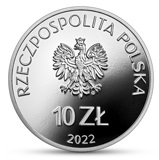
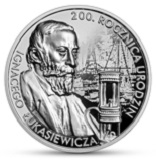
Nominał 10 zł … metal: Ag 999/1000; stempel: lustrzany, wysoki relief; średnica: 32,00 mm; masa: 31,10 g; brzeg (bok): gładki; nakład: do 10 000 szt.; Projektant: Dobrochna Surajewska; Emitent: NBP; Na zlecenie NBP monety wyprodukowała Mennica Polska S.A.
31 lipca 1853 roku salę operacyjną lwowskiego szpitala oświetliło światło lampy naftowej wynalezionej przez aptekarza Ignacego Łukasiewicza i wykonanej przez blacharza Adama Bratkowskiego. Była to pierwsza publiczna próba jej użycia. Rewolucyjna była nie sama lampa, ale zastosowanie nafty do jej opalania, uzyskanej w wyniku destylacji (destylacja frakcyjna) ropy naftowej. Osiągnięcie to zostało potwierdzone 2 grudnia 1853 roku patentem Austriackiego Urzędu Patentowego. Został on wydany na dwa nazwiska: Łukasiewicza i jego wspólnika Jana Zeha.
Oprócz odkrycia sposobu uzyskania nafty i wynalezienia lampy naftowej Łukasiewicz – jeszcze jako pracownik lwowskiej apteki Pod Złotą Gwiazdą – opracował metodę uzyskiwania preparatu aptecznego Oleum Petrae album, będącego oczyszczoną ropą naftową wykorzystywaną do celów leczniczych. Specyfik ten nie sprostał jednak zagranicznej konkurencji. Zmusiło to Łukasiewicza i jego wspólnika Zeha do poszukiwań nowych zastosowań ropy naftowej. Jej oczyszczenie i uzyskanie nafty dało początek przemysłowi naftowemu. Poczynania Łukasiewicza nie były nastawione na maksymalizację zysków. Według niego ropa to „bogactwo kraju, (…) dobrobyt i pomyślność mieszkańców, (…) nowe źródło zarobków dla biednego ludu i nowa gałąź przemysłu, która obficie zrodzi owoce”.
Jako gorący patriota wziął udział w przygotowaniach do powstania 1846 roku, za co był więziony i represjonowany. Wolnościowym poglądom pozostał wierny do końca życia – zarówno w sferze patriotyzmu narodowego, jak i działań społecznych. Jego postawa przejawiała się w myśli politycznej, gospodarczej oraz w poglądach społecznych. Łukasiewicz wspierał powstanie styczniowe. Był także założycielem Krajowego Towarzystwa Naftowego. Stał się prekursorem nowatorskich wówczas ubezpieczeń społecznych, kas brackich, samopomocowych i pożyczkowych czy opieki medycznej. Zakładał szkoły i szkółki, a pracę z ludem traktował jako budowanie świadomości narodowej chłopstwa. Wynalazki Łukasiewicza, organizacja wydobycia i przetwórstwa ropy, jego praca, a także osobowość zyskały uznanie potomnych i stawiają go w gronie czołowych polskich wynalazców oraz społeczników okresu zaborów. Na rewersie monety znajdują się wizerunek Ignacego Łukasiewicza, domniemany prototyp lampy naftowej oraz widok na założoną przez Łukasiewicza najstarszą na świecie kopalnię ropy naftowej w Bóbrce. Informacja: Wojciech Kalwat.

200th Anniversary of the Birth of Ignacy Łukasiewicz
www.nbp.pl
Narodowy Bank Polski is the central bank of the State, responsible for its monetary policy and price stability. The Bank’s functions are described in the Constitution of the Republic of Poland and the Act on NBP. NBP holds the exclusive right to issue the currency of the Republic of Poland. As the central bank, it does not provide accounts for the general public, accept deposits from or extend loans to individuals. It acts as a banker to the State budget and public sector entities. NBP also holds and manages the foreign exchange reserves of the State. Finally, it functions as a banker to banks, creating conditions for the operation of the Polish banking system. Narodowy Bank Polski is one of the most important research and analytical centres in the fields of economics and financial markets.
Issuing collector items is an occasion to commemorate important historic figures and anniversaries, as well as to develop the interest of the public in Polish culture, science, and tradition. On 8 March 2022, Narodowy Bank Polski issued into circulation a silver coin “200th Anniversary of the Birth of Ignacy Łukasiewicz”, with a face value of 10 złoty.


Face value: 10 zł … Metal: Ag 999/1000; Finish: proof, high relief; Diameter: 32.00 mm; Weight: 31.10 g; Edge (side): plain; Mintage: up to 10,000 pcs; Designer: Dobrochna Surajewska; Issuer: NBP; The coins, commissioned by NBP, were struck by Mennica Polska S.A.
On 31 July 1853, an operating theatre of a Lviv hospital was illuminated by the light of a paraffin lamp that was invented by pharmacist Ignacy Łukasiewicz and made by tinsmith Adam Bratkowski. It marked the first attempt to use the invention in a public space. What was revolutionary was not the lamp itself, but the use of paraffin to fuel it, which was obtained from crude oil by fractional distillation. The achievement was confirmed on 2 December 1853 by a patent granted by the Austrian Patent Office. It was issued in the two names of Ignacy Łukasiewicz and his associate Jan Zeh. In addition to devising a method for obtaining paraffin and inventing the paraffin lamp, while still working at the “Pod Złotą Gwiazdą” [Under the Golden Star] pharmacy in Lviv, Łukasiewicz also developed a method for producing the Oleum Petrae album pharmaceutical preparation, which was refined crude oil used for therapeutic purposes.
However, the medicine failed to face up to foreign competition and Łukasiewicz and his associate Zeh were thus forced to explore new uses of crude oil. Its refinement and obtaining paraffin triggered the development of the oil industry. Łukasiewicz’s actions were not driven by profit maximisation. He believed oil to be “the future wealth of the country, (…) the well-being and prosperity of its inhabitants, (…) a new source of income for the poor, and a new branch of industry which shall bear plentiful fruit.” As an ardent patriot, he took part in planning the insurrection in 1846, for which he was imprisoned and repressed. To the end of his life, he remained faithful to his pro-independence views in the spheres of both national patriotism and social activity. His attitude was manifested in his political and economic thinking, and in his social views.
Łukasiewicz supported the January Insurrection. He also founded the National Oil Society. He pioneered the then-innovative social insurance as well as for fraternal, self-help and loan funds, and medical care. He established schools and treated his work with the people as fostering national consciousness among the peasantry. Łukasiewicz’s inventions, the organisation of oil extraction and processing, his work and his personality earned him the recognition of posterity and place him among the leading Polish inventors and social activists of the period of the partitions. The reverse of the coin features the image of Ignacy Łukasiewicz, the presumed prototype of the paraffin lamp, and a view of the world’s oldest oil well established by Łukasiewicz in Bóbrka. Info: Wojciech Kalwat.

Wielcy polscy ekonomiści – Władysław Grabski
www.nbp.pl
Narodowy Bank Polski jest centralnym bankiem państwa odpowiadającym za politykę pieniężną i stabilność cen. Jego funkcje określa Konstytucja Rzeczypospolitej Polskiej i ustawa o NBP. NBP ma wyłączne prawo emisji pieniądza. Jako bank centralny nie prowadzi rachunków bankowych obywateli, nie przyjmuje od nich lokat, nie udziela kredytów. Prowadzi natomiast obsługę budżetu państwa, a także podmiotów sektora finansów publicznych. Gromadzi rezerwy walutowe państwa i zarządza nimi. Pełni funkcję banku banków, tworząc warunki do działania systemu bankowego. Jest również jednym z najważniejszych ośrodków naukowo-analitycznych w dziedzinie ekonomii i rynków finansowych.
Emisja wartości kolekcjonerskich stanowi okazję do upamiętniania ważnych historycznych rocznic i postaci oraz do rozwijania zainteresowań polską kulturą, nauką i tradycją. 21 kwietnia 2022 roku Narodowy Bank Polski wprowadził do obiegu srebrną monetę o nominale 10 zł z serii „Wielcy polscy ekonomiści” – „Władysław Grabski”.
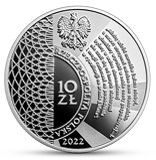
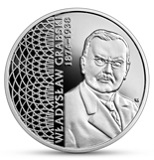
Nominał 10 zł … metal: Ag 925/1000; stempel: lustrzany; średnica: 32,00 mm; masa: 14,14 g; brzeg (bok): gładki; nakład: do 10 000 szt.; Projektant: Dominika Karpińska-Kopiec; Emitent: NBP; Na zlecenie NBP monetę wyprodukowała Mennica Polska S.A.
Na rewersie monety znajdują się wizerunek Władysława Grabskiego oraz daty jego urodzin i śmierci. Na awersie widnieje cytat pochodzący z artykułu Wychowanie publiczne jako czynnik sanacji gospodarczej z dzieła O własnych siłach. Zbiór artykułów na czasie.
Władysław Grabski (1874–1938) był politykiem, działaczem społecznym i ekonomistą. Pochodził ze starej szlacheckiej rodziny. Kształcił się w Polsce, Francji oraz Niemczech. W młodości sympatyzował z ideami socjalistycznymi, ale szybko zbliżył się do nurtu narodowego. W 1905 r. został aresztowany przez władze carskie i na krótko osadzony na Pawiaku za udział w kampanii na rzecz samorządu i polonizacji instytucji publicznych w Królestwie Polskim. Trzykrotnie posłował do rosyjskiej Dumy w latach 1905–1912. Po wybuchu I wojny światowej został członkiem Centralnego Komitetu Obywatelskiego oraz Komitetu Narodowego Polskiego. W 1918 r. przez krótki czas był więziony przez Niemców jako reprezentant orientacji antyniemieckiej. W 1919 r. zdobył mandat posła na Sejm Ustawodawczy z ramienia Związku Ludowo-Narodowego, po czym objął tekę ministra skarbu w rządzie Leopolda Skulskiego. Po raz pierwszy został premierem w okresie wojny polsko-bolszewickiej w 1920 r. Reprezentował Polskę na międzynarodowej konferencji w Spa, jednak niepowodzenie rokowań spowodowało dymisję Grabskiego.
W latach 1923–1925 ponownie stanął na czele rządu, w którym pełnił także obowiązki ministra skarbu. Pod jego kierownictwem dokonano reformy walutowej i skarbowej, czego efektem były wprowadzenie nowej waluty – złotego, sanacja budżetu państwa i zdławienie hiperinflacji. Ustąpił ze stanowiska w 1925 r., po czym wycofał się z życia politycznego, poświęcając się pracy naukowej i publicystycznej. Grabski opublikował wiele prac z zakresu ekonomii agrarnej, upatrując w warstwie chłopskiej fundament siły narodu. Stworzył podwaliny nowej dziedziny nauki – socjologii wsi. W 1935 r. opublikował dzieło Idea Polski, w którym dokonał analizy sytuacji wewnętrznej Polski, przestrzegając przed licznymi niebezpieczeństwami grożącymi odrodzonej Rzeczypospolitej. Z innych najważniejszych prac Władysława Grabskiego należy wymienić: Historię Towarzystwa Rolniczego, Materiały w sprawie włościańskiej, Dwa lata pracy u podstaw państwowości naszej (1924-1925), O własnych siłach. Informacja: Grzegorz Jeż.

The Great Polish Economists – Władysław Grabski
www.nbp.pl
Narodowy Bank Polski is the central bank of the State, responsible for its monetary policy and price stability. The Bank’s functions are described in the Constitution of the Republic of Poland and the Act on NBP. NBP holds the exclusive right to issue the currency of the Republic of Poland. As the central bank, it does not provide accounts for the general public, accept deposits from or extend loans to individuals. It acts as a banker to the State budget and public sector entities. NBP also holds and manages the foreign exchange reserves of the State. Finally, it functions as a banker to banks, creating conditions for the operation of the Polish banking system. Narodowy Bank Polski is one of the most important research and analytical centres in the fields of economics and financial markets.
Issuing collector items is an occasion to commemorate important historic figures and anniversaries, as well as to develop the interest of the public in Polish culture, science and tradition. On 21 April 2022, Narodowy Bank Polski issued into circulation a silver coin of the series “The Great Polish Economists” – Władysław Grabski, with a face value of 10 złoty.


Face value 10 zł … Metal: Ag 925/1000; Finish: proof; Diameter: 32.00 mm; Weight: 14.14 g; Edge (side): plain; Mintage: up to 10,000 pcs; Designer: Dominika Karpińska-Kopiec; Issuer: NBP; The coins, commissioned by NBP, were struck by Mennica Polska S.A.
The reverse of the coin features the image of Władysław Grabski and the dates of his birth and death. On the obverse, there is a quote from the article entitled. Wychowanie publiczne jako czynnik sanacji gospodarczej [Public education as a factor of economic recovery] from his work O własnych siłach. Zbiór artykułów na czasie [On our own. A collection of up-to-date articles].
Władysław Grabski (1874–1938) was a politician, social activist and economist. He came from an old family of the landed gentry. He studied in Poland, France, and Germany. In his youth, he sympathised with socialist ideas but quickly moved closer to the nationalist ideology. In 1905, he was arrested by the Tsarist authorities and briefly imprisoned at the Pawiak prison for participating in a campaign for self-government and the polonisation of public institutions in the Kingdom of Poland. He was a delegate to three successive sessions of the Russian Duma in the years 1905 –1912. After the outbreak of World War I, he became a member of the Central Citizens’ Committee (Centralny Komitet Obywatelski) and the Polish National Committee (Komitet Narodowy Polski). In 1918, he was briefly imprisoned by the Germans as a representative of the anti-German sentiment. In 1919, he was elected a member of the Legislative Sejm (Sejm Ustawodawczy) on behalf of the Popular National Union (Związek Ludowo-Narodowy), and then he became Treasury Minister in the government of Leopold Skulski.
Grabski became Poland’s prime minister for the first time during the Polish-Soviet War in 1920. He represented Poland at the international conference in Spa, but the failure of the negotiations resulted in Grabski’s resignation. In the years 1923–1925, he once again became head of the government, in which he also served as Minister of the State Treasury. Under his leadership, the Polish government carried out currency and fiscal reforms, which resulted in the introduction of a new currency, the Polish złoty, improvement of the state budget, and suppression of hyperinflation. He resigned from his post in 1925, after which he withdrew from political life, devoting himself to scientific and journalistic work. Grabski published many works in the field of agrarian economy, seeing the peasant class as the foundation of the nation’s strength. He laid the groundwork for a new area of science – rural sociology. In 1935, he published a paper entitled Idea Polski [An Idea of Poland], in which he analysed the internal situation of Poland, warning against the numerous dangers threatening the recently reborn Polish Republic. Other key works by Władysław Grabski include Historia Towarzystwa Rolniczego [The history of the Agricultural Society], Materiały w sprawie włościańskiej [Case materials on the issue of peasants], Dwa lata pracy u podstaw państwowości naszej (1924-1925) [Two years of work at the foundations of our statehood (1924-1925)], O własnych siłach [On our own]. Info: Grzegorz Jeż.


Calla: PermanentTM domestic rate stamps
www.canadapost.ca
This booklet of 10 PermanentTM domestic rate stamps offers two depictions of the calla (Zantedeschia), with five stamps of each design. The booklet contains 5 white and 5 pink calla stamps. The white calla stamp features two white Callas, with green leaves on a pink background. The pink calla stamp features a single pink calla, with green leaves on a burgundy background.
Native to the southern parts of Africa, Callas (Zantedeschia) was used medicinally before becoming prized around the world for their beauty and their longevity as cut flowers. The white Zantedeschia aethiopica remains the most popular species, but there are now many hybrids, in shades of orange, pink, purple, yellow and nearly black. In the Victorian language of flowers, Callas has ascribed a variety of different meanings, depending on their colour. White signifies purity and innocence, while pink conveys admiration and appreciation and near-black evokes elegance and mystery.
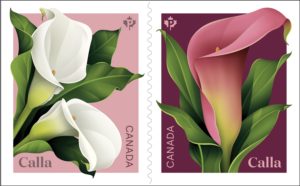
Sometimes referred to as calla lilies, these lovely plants are not lilies at all but members of the unusual arum family (Araceae), which also includes skunk cabbage, jack-in-the-pulpit and peace lily. The sophistication and elegance of Callas make them a popular flower for weddings, as well as other celebrations and remembrances. Stamp Designer: Paprika. Stamp Illustrator: Fanny Roy. Stamp Value: Permanent™ domestic rate. Quantity Produced: 700,000. Issue Date March 1, 2022.
This souvenir sheet for the annual flower stamp issue for 2022 features both stamp designs and depicts the calla (Zantedeschia) in white and pink. The souvenir sheet image is of one curled, white calla and one pink calla in full bloom. Quantity Produced 70,000.
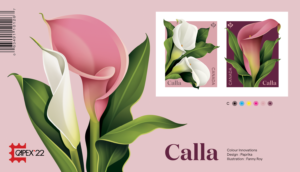
This special souvenir sheet overprint featuring the two calla stamps of the 2022 flower issue is released in anticipation of CAPEX 22 – an international philatelic exhibition, to be held in Toronto, June 9 to 12, 2022. The souvenir sheet image is of one curled, white calla and one pink calla in full bloom. The CAPEX 22 logo is placed in the lower-left corner. Quantity Produced 40,000.
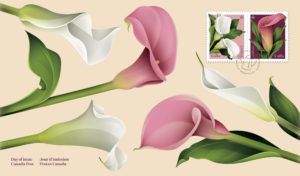
This combo Official First Day Cover for 2022’s edition of the annual flower stamp issue features the issue’s two Callas (Zantedeschia) stamps. The OFDC features both stamps and elegant illustrations by stamp illustrator Fanny Roy. There are three white Callas and three pink Callas over a light, sand-coloured background. The cancellation mark, positioned between and touching the two stamps, is a line drawing of a watering can. The cancel location is Brampton, ON, known as the “Flower City” of Canada. Quantity Produced: 7,000. The issue date for the flower stamps is March 1, 2022.


2022 … $20 Pure Silver Coin –
Her Majesty Queen Elizabeth II’s Diamond Diadem
www.mint.ca
We reserved Her Majesty’s most famous royal headpiece for the Platinum Jubilee! The Diamond Diadem is spectacular yet familiar—it’s the royal headpiece that has appeared in countless portraits since Her Majesty acceded to the throne in 1952. It is one of the most recognizable symbols of Her Majesty’s 70-year reign, and for this reason, it is the inspiration for this year’s 99.99% pure silver tribute to the Queen of Canada in her Platinum Jubilee year. The coin’s reverse features a rhodium-plated embellishment that resembles the diadem’s cross and floral sprays. Adorned with Swarovski® crystals, the arrangement sparkles brilliantly against the matte proof finish, which ensures all eyes are on this jewellery-themed design.
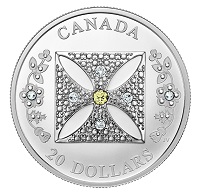
Face value: $20 dollars … Composition: 99.99% pure
silver with Swarovski® crystals;
Mintage: 4,500; Finish: Matte proof; Weight: 31.39 g;
Diameter: 38 mm; Edge: serrated; Certificate: serialized;
Artist: Jori van der Linde (reverse), Susanna Blunt (obverse).
THE DIAMOND DIADEM … The regal Diamond Diadem is also known as the George IV State Diadem because it was originally created for the coronation of King George IV in 1821. It has since been exclusively worn by queens regnant and consort, beginning with Queen Adelaide and continuing with Queen Victoria, who designated it an Heirloom of the Crown in 1901. Its silver frame is lined with gold and set with 1,333 brilliant-cut diamonds, including a four-carat yellow brilliant at the centre of the front cross. Its narrow band is edged with pearls and surmounted by four crosses pattée and four sprays featuring a rose for England, shamrocks for Ireland and a thistle for Scotland.
DESIGN … Designed by Canadian artist Jori van der Linde, your coin’s reverse features an artistic representation of the famous Diamond Diadem worn by Her Majesty Queen Elizabeth II. Swarovski® crystals add a diamond-like sparkle to the rhodium-plated embellishment, which resembles the diadem’s cross and the floral sprays representing the national emblems of England, Ireland and Scotland. The reverse includes the inscription “CANADA” at the top and “20 DOLLARS” at the bottom. The obverse features the date “2022” and the effigy of Her Majesty Queen Elizabeth II by Susanna Blunt.
DID YOU KNOW?… *** Although Queen Alexandra and Queen Mary wore the Diamond Diadem for family events, Her Majesty Queen Elizabeth II has mostly worn the Diamond Diadem on State occasions. Since her accession to the throne in 1952, Her Majesty has worn the diadem while travelling to and from the annual State Opening of (United Kingdom) Parliament, and also during the coronation procession in 1953. *** Her Majesty can be seen wearing the Diamond Diadem in many official portraits, and on banknotes, postage stamps and coins… including ours! The diadem can be seen on the obverse of most Canadian coins issued between 1990 and 2002 when they typically featured the effigy by Dora de Pédery-Hunt.

2022 … $250 Pure Gold Coin –
Her Majesty Queen Elizabeth II’s Diamond Diadem
www.mint.ca
Spectacular yet familiar, the Diamond Diadem is the royal headpiece that has appeared on countless banknotes, stamps and coins since Her Majesty acceded to the throne in 1952. The regal accoutrement has become synonymous with Her Majesty’s historic 70-year reign, and for this reason, it is the inspiration for this 99.99% pure gold tiara tribute on the occasion of Her Majesty’s Platinum Jubilee. The coin’s reverse is adorned with seven diamonds, including a yellow one (a first for us) that adds authentic sparkle to our artistic representation of the diadem’s distinctive cross pattée and floral sprays.
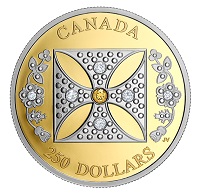
Face value: $250 dollars … Composition: 99.99% pure gold
with diamonds and selective platinum plating;
Mintage: 225; Finish: Proof; Weight: 60.08 g;
Diameter: 38 mm; Edge: serrated; Artist:
Jori van der Linde (reverse), Susanna Blunt (obverse).
THE DIAMOND DIADEM … The regal Diamond Diadem is also known as the George IV State Diadem because it was originally created for the coronation of King George IV in 1821. It has since been exclusively worn by the queen’s regnant and consort beginning with Queen Adelaide and continuing with Queen Victoria, who designated it an Heirloom of the Crown in 1901. Its silver frame is lined with gold and set with 1,333 brilliant-cut diamonds, including a four-carat yellow brilliant at the centre of the front cross; its narrow band is edged with pearls and surmounted by four crosses pattée and four sprays featuring a rose for England, shamrocks for Ireland and a thistle for Scotland.
DESIGN … Designed by Canadian artist Jori van der Linde, your coin’s reverse is adorned with seven genuine diamonds and features an artistic representation of the famous Diamond Diadem worn by Her Majesty Queen Elizabeth II. The platinum-plated motif resembling the diadem’s front cross is set with a yellow gold diamond and flanked by floral sprays that combine the emblems of England, Ireland and Scotland. The reverse includes the inscription “CANADA” at the top and “250 DOLLARS” at the bottom. The obverse features the date “2022” and a field pattern behind the effigy of Her Majesty Queen Elizabeth II by Susanna Blunt.
DID YOU KNOW?… *** Although Queen Alexandra and Queen Mary wore the Diamond Diadem for family events, Her Majesty Queen Elizabeth II has mostly worn the Diamond Diadem on State occasions. Since her accession to the throne in 1952, Her Majesty has worn the diadem while travelling to and from the annual State Opening of (United Kingdom) Parliament; it was also worn during the coronation procession in 1953. *** Her Majesty can be seen wearing the Diamond Diadem in many official portraits, as well as banknotes, postage stamps and coins. The diadem can be seen on the obverse of most Canadian coins issued between 1990 and 2002 when they typically featured the effigy by Dora de Pédery-Hunt.

2022 … O Canada Gift Coin Set
www.mint.ca
Celebrate Canada with this fun and memorable 5-coin set. The set features a unique $1 coin designed exclusively for this very special occasion! It also includes 2022 dated $2, 25¢, 10¢ and 5¢ coins with traditional designs. Give the gift that will be cherished for years to come!

Dollar Set … Dollar Composition: Base metal;
Mintage: 100,000; Finish: Uncirculated;
Weight: 6.27 g; Diameter: 26.5 mm; Edge: serrated;
Artist: Steve Hepburn (reverse); Susanna Blunt (obverse).
A wonderful gift for anyone who has a special place in their heart for Canada! The 2022 O Canada Gift Card Set is a reminder of what makes our nation great: its $1 coin features a design that is both fun and imaginative, but it also serves as a symbol of pride and appreciation for this beautiful country of ours. Inside the card-like packaging, you’ll find the five 2022-dated Canadian circulation coins.

Design: Features a specially struck $1 piece that is only available as part of this gift card set. Designed by Canadian artist Steve Hepburn, the dollar coin’s playfully patriotic reverse combines two famous symbols of Canada: the beaver and the Canadian flag.
Did you know? … The beaver is twice featured in the 2022 O Canada Gift Card Set—on the $1 coin and on the 5-cent coin. It played a big role in early Canadian history (its fur was the main export in the 1600s and 1700s), and as such, Castor canadensis has officially designated an emblem of Canada in 1975.

2022 … $20 Pure Silver Coin –
Discovering Dinosaurs: Mercury’s Horned Face
www.mint.ca
A follow-up to 2021’s Reaper of Death! Mercury’s Horned Face or Mercuriceratops gemini is the featured star of our second Discovering Dinosaurs coin, and the first things you’ll notice about this ceratopsid are the bony, wing-like protrusions on its head. Engraved on the coin’s reverse, its skull fossil is especially striking against the black rhodium-plated “rock” background, which pays tribute to the discovery that yielded another piece of Canada’s prehistoric past.
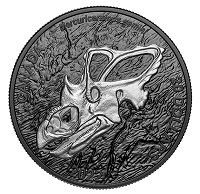
Face value: $20 dollars … Composition: 99.99% pure silver
with selective rhodium plating; Mintage: 10,000;
Finish: matte proof; Weight: 31.39 g; Diameter: 38 mm;
Edge: serrated; Certificate: serialized;
Artist: Julius Csotonyi (reverse), Susanna Blunt (obverse).
DESIGN … Designed by Canadian paleoartist Julius Csotonyi, the coin’s reverse features the fossilized skull of Mercuriceratops gemini, a recently discovered horned dinosaur species. Beneath the black rhodium plating, the engraved texture represents the rock formation in Alberta’s Dinosaur Provincial Park where a key fossil fragment was found. The obverse also features rhodium plating behind the effigy of Her Majesty Queen Elizabeth II by Susanna Blunt.
DID YOU KNOW? … *** Its unusual frill may look scary, but it likely helped Mercuriceratops to attract a mate. Unveiled in 2014, this six-metre-long herbivore was described from near-identical skull fragments of two individuals—one recovered from Dinosaur Provincial Park in Alberta and the other from the Judith River Formation in Montana (United States)—hence the species name, gemini (“twin” in Latin). *** The genus name, Mercuriceratops, means “Mercury’s horned face.” It was named after Mercury, the Roman messenger to the gods, who is often depicted with wings on his helmet.

2022 … $30 Pure Silver Coin –
Multifaceted Animal Family: Bald Eagles
www.mint.ca
Whether soaring in solitude or surveying from atop the tallest tree, the bald eagle is celebrated as a sharp-eyed symbol of strength. But the regal raptor can be surprisingly tender—it provides nourishment and models behaviours for its young to ensure that the next generation survives and thrives. This is a side of the bald eagle that often goes unseen, and it is represented on the reverse of this 2 oz. 99.99% fine silver coin, where multifaceted engraving adds dimension to the eagle and eaglets, resulting in a new and visually striking portrait that shows this species from a whole new angle.
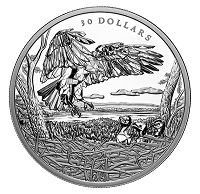
Face value: $30 dollars … Composition: 99.99% pure silver;
Mintage: 4,500; Finish: Proof; Weight: 62.69 g;
Diameter: 50 mm; Edge: serrated; Artist:
Steve Hepburn (reverse), Susanna Blunt (obverse).
DESIGN … The reverse design by Canadian artist Steve Hepburn offers a rare glimpse of a bald eagle (Haliaeetus leucocephalus) family. The wildlife portrait is enhanced with multifaceted engraving that gives the parent and the three eaglets a more three-dimensional form, as the mother returns to her treetop nest. The obverse features a polygon pattern and the effigy of Her Majesty Queen Elizabeth II by Susanna Blunt.
BEHIND CLOSED DOORS …”The Bald Eagle symbolizes strength, beauty and power, but it is also synonymous with characteristics like loyalty, wisdom and courage. This design uses a unique angle, from high up in the tree canopy, to show the magnificent eagle returning to her three eaglets and swooping down with outstretched wings, which showcases the beauty and structure of the feathers. The young birds are completely reliant on the skill and nurturing care of their parents for the first few months of life. Living on the coast of British Columbia, I am fortunate to see bald eagles on a regular basis, and when I come across a large nest, I’m always hopeful that I’ll hear the high-pitched chirps of eaglets.” – Steve Hepburn, Artist.
DID YOU KNOW? *** Bald eagles build the largest nests—these can average about 1 metre tall, though larger nests have been reported. It’s not clear whether the male or female selects the site, but they tend to nest in tall trees that provide them with a commanding view and easy flight access. *** Eaglets hatch after a 35-day incubation period and remain in the nest for 10-12 weeks. During the first weeks, the parents will shield the young from the elements and carry food back to the nest. Young eagles develop their flight and hunting skills at their own pace, and they’re largely independent after the second month.


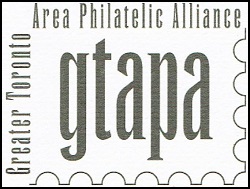
www.gtapa.org
The GTAPA is committed to promote and stimulate
the art of philately to all ages for fun,
culture, education, and friendship.


CAPEX 22
www.capex22.org
CAPEX 22 International One Frame Stamp Championship Exhibition will be held June 9-12, 2022 at the Metro Toronto Convention Centre (MTCC) in the heart of Toronto’s downtown entertainment district. With 400+ frames, CAPEX 22 will be the largest showing of one-frame exhibits at any exhibition, ever.

The exhibition will also have a wonderful array of philatelic literature exhibits both in traditional print format and with four categories of digital literature including philatelic websites. The exhibition’s bourse area will consist of more than 75Canadian and International dealers, providing a full range of philatelic material for exhibition attendees. CAPEX 22 is being held under the patronage of the Federacion Interamericana de Filatelia (FIAF) and with the recognition of Federation Internationale de Philatélie (FIP).

